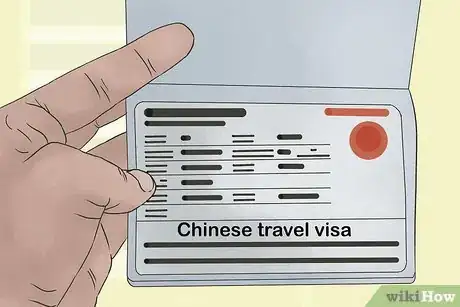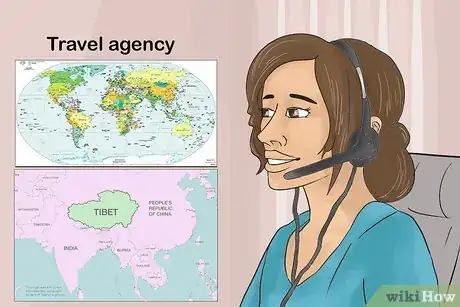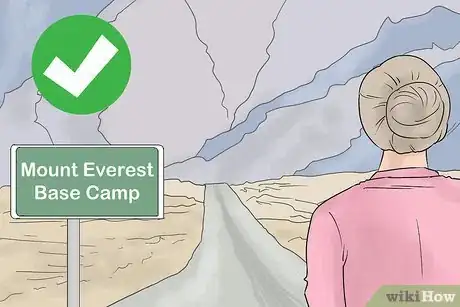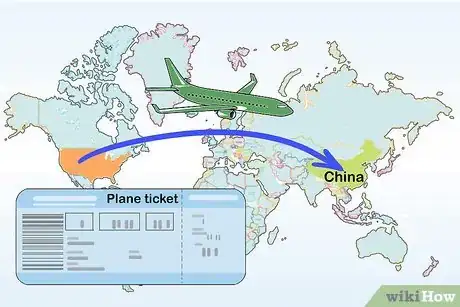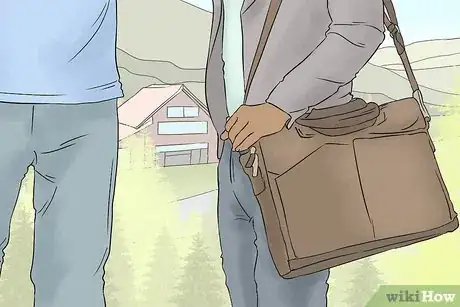This article was co-authored by wikiHow Staff. Our trained team of editors and researchers validate articles for accuracy and comprehensiveness. wikiHow's Content Management Team carefully monitors the work from our editorial staff to ensure that each article is backed by trusted research and meets our high quality standards.
There are 10 references cited in this article, which can be found at the bottom of the page.
This article has been viewed 6,041 times.
Tibet is a traveller’s dream destination, with stunning high altitude views, ancient monasteries, and a rich local culture. To get to this vast region, you will need to make arrangements ahead of time so your trip goes as planned. Start by getting the necessary travel documents so you can legally enter Tibet. Then, make a detailed itinerary so you see all that Tibet has to offer. Arrange your transportation and accommodations, and pack smart so your trip to Tibet is fun and memorable.
Steps
Getting the Necessary Travel Documents
-
1Get a Chinese travel visa. You will first need to have a travel visa for travel to China, as you can only get to Tibet by traveling through China. Apply for a Chinese travel visa at a Chinese consulate or embassy in your area. Most travellers who are visiting China as a tourist will need to apply for an “L”category visa.[1]
- As part of the application, you will need to provide a copy of your passport and a passport grade photo of yourself.
- The fee for a single entry visa to China for U.S. citizens is $140 USD. The fee for non-U.S. citizens is $30 USD.
- It will take 4 business days for the visa to be processed.
-
2Find a Tibet-based travel agency. Travellers cannot legally visit Tibet on their own, as the Chinese government does not allow this. You must hire a Tibet-based travel agency and book a guided tour. The travel agency will then arrange the necessary travel documents for you for a fee.[2]
- Search for a Tibet-based travel agency online. Read online forums to find agencies that are reputable and based in Tibet, as this will allow you to support the Tibetan economy directly and ensure the agency will arrange your trip properly.
-
3Apply for travel documents to Tibet through the agency. Do this at least 4-6 weeks before your trip to Tibet. You will need to provide your itinerary in Tibet to the agency to apply for the documents, as you will need get approval to travel to each area on your itinerary. Some agencies will make the itinerary for you, allowing you to simply pay a fee and not worry about planning the trip yourself.[3]
- Depending on where you plan to travel in Tibet, you will need four permits: the Tibet Travel Permit, an Alien Travel Permit, a Military Permit, and a Foreign Affairs Permit. The travel agency will determine which permits you need based on your itinerary.
- You will also need to provide a copy of your Chinese travel visa to apply for travel permits to Tibet.
-
4Pay for the documents and get them in the mail. The cost for your travel documents will depend on which permits you require. Each permit can range in cost from $50-$100 USD. The travel agency may include the cost of your travel documents as part of a package with your transportation and accommodations. Once your permits have been processed, you will receive hard copies in the mail.[4]
- Keep in mind you cannot make changes to your itinerary once you receive your permits, so confirm you are happy with your travel plans before you pay for the permits.
- You can arrange your permits with the travel agency before you land in China to avoid any wait time.
-
5Bring your documents with you when you travel to Tibet. You will need to bring hard copies of the original permits with you so you can show them to officials when you enter Tibet.[5]
- Make copies of your permits and keep them somewhere safe so you have backups just in case.
Determining Your Travel Itinerary
-
1Visit Tibet in spring or summer for the best weather. Tibet is the warmest and greenest during the summer and spring months, making it ideal for travel. It can reach 20 °C (68 °F) and higher during summer and spring. However, it can also get very crowded, so you will need to be prepared for a lot of tourists if you visit during this time.[6]
- July and August are the rainy months in Tibet so you may want to avoid traveling during this time.
- Avoid traveling to Tibet in May, as it can be difficult to book transportation and accommodations due to national holidays in China.
-
2Go to Tibet in the fall or winter for low season. The weather will be much colder in the fall and winter, but it will be less crowded. You will also get cleared views of the mountains during the winter and fall months.[7]
- Temperatures can drop to below 0 °C (32 °F) at night during the winter, especially in January and February. The fall months will be warmer, but still chilly.
- Each year, the Chinese government closes Tibet in February. Keep an eye on Chinese government announcements and check with your tour guide to see if you are able to travel to the region during this month.
- Chinese people tend to travel to Tibet in early October for national holidays, so you may avoid travel during this month if you do not like heavy traffic and crowds.
-
3Do guided tours of holy sites and monasteries. When you arrange your trip through a travel agency, they will find you a suitable tour guide to take you around Tibet. Your tour guide will take you to temples and monasteries, providing detailed information and context at each site. There is usually a small entrance fee to enter these holy sites.[8]
- Popular holy sites in Tibet include the Sera monastery and the Potala Palace. Your tour guide should be able to suggest other sites to visit.
- Always follow the posted rules for any holy sites you visit.
-
4Go to local markets and teahouses in Lhasa. Other popular attractions include the open air markets and teahouses in Lhasa, the capital city of Tibet. You can buy local goods at the markets and try local food at the teahouses.[9]
- Most meals are inexpensive in Lhasa and focus on local, traditional foods.
-
5Include a visit to remove areas of Tibet. The area around Tibet, called the Tibet Autonomous Region (TAR), contains popular areas like the Mount Everest Base Camp and the Friendship Highway. Your guide can arrange road trips to these areas, where you travel by private car or bus.[10]
- You will need to be prepared to spend a lot of time in the car, looking out the window at scenic views.
- Hiking and climbing around Mount Everest may require additional permits, and extensive outdoor experience. Speak to your tour guide for more information.
Arranging Your Transportation and Accommodations
-
1Fly into China. Book a ticket to China at least 3-4 months before you plan to travel. You may land in Beijing, the capital city, if you want to explore northern China a bit before going to Tibet. If you want to make getting to Tibet easier, you may fly into a central city like Chengdu or a southern city like Guangzhou.
- Consider your budget and your travel itinerary. If you have some money and time, you may fly into Beijing, explore for a few days, and then find transportation to Tibet. Or it may be more economical for you to fly to Chengdu and then go straight to Tibet so you can spend most of your travel time there.
-
2Take the train from a major Chinese city to Tibet. You can take the train daily from Xining, Lanzhou, Chengdu, Chongqing, Beijing, Guangzhou, and Shanghai. The train is an inexpensive option if you are traveling on a budget. Book them earlier to ensure you get a spot.[11]
- Taking the train from major cities like Beijing and Chengdu may be easier, but the train ride will be longer than if you depart from a central city like Chengdu or a southern city like Guangzhou.
- Leaving from Xining may be the best option if you want to have an easier time getting used to the altitude change and prefer a shorter train trip.
- The train can cost CNY500-CNY750 ($75-$115 USD) one way, depending on which city in China you depart from.[12]
-
3Fly to Tibet from China. If you’d prefer to go by plane, you can fly out from Chengdu, Xi’an, Beijing, Shanghai, Guangzhou, and Chongqing. Beijing and Shanghai are major cities so you may find it easier to get a flight to Tibet. However, the flights will be longer than flying out of Xi'an, Chongqing, or Guangzhou. Chengdu may be the best option, as it offers 6-10 flights a day to Lhasa.[13]
- The cost of flights can vary depending on where you are flying from. Compare prices online to find flights within your budget.
- Your tour guide may be able to arrange flights for you as part of your travel package to Tibet.
-
4Book a hotel in advance through a tour guide. The easiest way to arrange accommodations is to do it through your tour guide. They can usually offer you a variety of accommodations, from five star hotels to budget hotels or hostels. Give the tour guide a sense of your budget and what type of accommodation you want. They can then book it for you so you do not have to worry about it when you arrive.[14]
- Most hotels in Tibet do not have a website or an online booking option, so you will need to do this in person or through your tour guide.
-
5Find accommodations in remote areas in person. If you plan to travel in remote areas of Tibet, you do not need to reserve accommodations in advance. Instead, you can get a list of hotels from your tour guide and book them in person when you arrive.[15]
- Your tour guide can also arrange accommodations in remote areas for you in advance.
Making Final Arrangements
-
1Bring medication for altitude sickness. Get altitude sickness medication from your doctor or pharmacist. Start taking it the day before you arrive in Tibet to help your body get used to the medication. Follow your doctor’s or pharmacist’s instructions on dosage and never take more than the recommended amount.
- If you'd prefer a more natural option, you can take a supplement like ginkgo balboa to help with altitude sickness.
- It may take a few days for you to get used to the high altitudes in Tibet. Make sure you take the medication to help you feel less nauseous and sick.
-
2Pack long sleeve shirts and pants for visiting holy sites. You will need to keep your bare legs and arms covered when you are in temples or monasteries in Tibet, as it is part of the local custom. Make sure you pack comfortable travel pants and shirts with long sleeves.[16]
- You can also bring a scarf or wrap to cover your arms easily when you go into holy sites.
-
3Bring layers and warm clothing. The high altitudes of Tibet means you may experience cold nights and temperate weather during the day. Pack breathable tops and a warm jacket that you can layer underneath. Bring close toed shoes that are comfortable for walking.
-
4Get Chinese currency before you arrive in Tibet. Chinese currency, RMB, is accepted in Tibet. Take out Chinese currency when you are in China and bring it with you so you have cash on hand. Keep the cash in a money belt or a small bag that you put around your neck and tuck in your clothing so it stays safe.[17]
- You should be able to find an ATM or a currency exchange in Lhasa to take out more cash if needed. Your tour guide can also help you exchange or take out Chinese currency when you get to Lhasa.
- It may be more difficult to find an ATM in remote areas of Tibet so make sure you have enough cash on you for your travels to these areas.
- Avoid using your credit card when you are in Tibet, as the high altitude can make it difficult for your credit card to go through properly. Cash is the best option.
- Let your bank at home know that you are travelling to Tibet so they do not freeze your card or view your card activity as suspicious.
-
5Learn basic words and phrases in Tibetan. Search for online guides on how to speak basic Tibetan phrases like "Welcome," "Hello," "Thank you" and "How are you?" Tibetan uses characters, but you can learn the pronunciations of certain words or phrases phonetically so you can say them to locals.[18]
- You can also get a Tibetan phrase book or an audio recording of different phrases that you can listen to and learn.
-
6Get international minutes on your cellphone. Contact your cellphone company and add international minutes to your plan so you can use it when you are in Tibet. Most high traffic areas and cities, such as Lhasa, will have cellphone and Internet service. However, the signal may be poor in remote areas of Tibet.[19]
- Many hotels in Tibet will have Internet service, wifi, and phone lines you can use.
-
7Speak to your tour guide for more information before your trip. Your tour guide can help you decide what to pack and what to expect on your travels to Tibet. They may send out a list of items to pack as well as a detailed itinerary before you embark on your trip.
- You can also refer to guidebooks on Tibet for more information. Look for travel guidebooks about Tibet that are current and up to date so you know what to expect.
References
- ↑ http://www.china-embassy.org/eng/visas/hrsq/
- ↑ http://www.thelandofsnows.com/travel-in-tibet/
- ↑ http://www.thelandofsnows.com/travel-in-tibet/
- ↑ http://www.thelandofsnows.com/travel-in-tibet/
- ↑ https://www.chinahighlights.com/tibet/travel-tips.htm
- ↑ https://www.yowangdu.com/tibet_travel.html
- ↑ https://www.yowangdu.com/tibet_travel.html
- ↑ https://www.wildjunket.com/how-to-travel-tibet-guide/
- ↑ https://www.wildjunket.com/how-to-travel-tibet-guide/
- ↑ https://www.wildjunket.com/how-to-travel-tibet-guide/
- ↑ http://www.thelandofsnows.com/travel-in-tibet/
- ↑ https://www.chinatibettrain.com/fares.htm
- ↑ http://www.thelandofsnows.com/travel-in-tibet/
- ↑ http://www.thelandofsnows.com/travel-in-tibet/
- ↑ http://www.thelandofsnows.com/travel-in-tibet/
- ↑ https://www.travelchinaguide.com/essential/tibet/
- ↑ https://www.tibettravel.org/tibet-travel-advice/money-and-banking.html
- ↑ https://www.omniglot.com/language/phrases/tibetan.php
- ↑ http://www.chinaprivatetravel.com/faq/tibet.htm#cws
